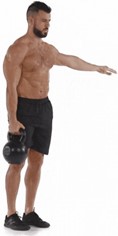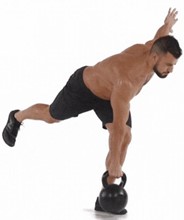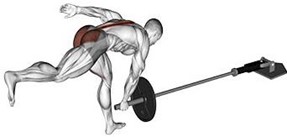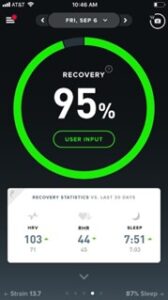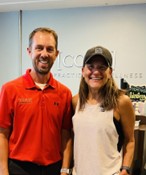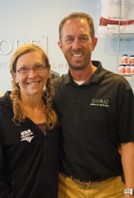We are continuing our look at some of the myths surrounding marathon training. If you missed our first newsletter detailing these myths you can find it and many other articles on various health topics on our website. Don’t forget these articles are also published on our social media pages. Just search for Core Roanoke and make sure to follow us. Thanks again to our local contributors for making this newsletter even better!
You Only Need Long Slow Distance (LSD) Training
The most common marathon training myth might be that you only need long slow distance runs during training. It makes reasonable sense that in order to complete an endurance event such as a marathon where most recreational runners will be moving for 3-5 hours continuously, logging longer mileage runs at a slower pace would be essential to build aerobic capacity. I wholeheartedly agree! However, as Matt Fitzgerald outlines in his book, 80/20 Running, the 80/20 principle explains 80 percent of our weekly mileage should be performed at a relatively low intensity (Zone 1-2 effort) while the remaining 20 percent should consist of some higher intensity interval style training (Zone 4-5 effort). This higher intensity work can take the form of strides, VO2 max repeats, tempo runs, hill sprints, fartleks, or even higher intensity cross training. Essentially, these higher intensity sessions allow the body a different metabolic stimulus than it is used to with long slow distance running by tapping into the anaerobic glycolytic and phosphagenic energy pathways. Additionally, sprinkling in these interval sessions gives us an opportunity to work on running economy as we should be running more efficiently at these higher speeds. In turn, this can help break up the monotony of long slow distance and keep the body feeling fresh each week in preparation for race day. Many popular marathon training plans will begin with dedicated weekly interval sessions roughly 7-8 weeks out from race day. Although, you can certainly include several strides and/or form drills at the end of one run each week earlier than this time frame.
David Angel states why these speed intervals can have such great benefits, “Continuing to do speed work and some long extended efforts at your goal marathon pace are necessary for fitness gains, but also for the mechanical aspects. In the late miles of a marathon, the limiting factor isn’t always energy levels or fitness. It’s possible to still feel perfectly fine aerobically, but if the legs and muscles decide to cramp, there is not much you can do about it. Continuing to work on speed and harder efforts during training will help the legs be better prepared for what you’re asking of them on race day.”
Runners Need To Stretch Their Hamstrings More
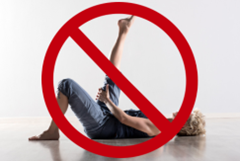 Static stretching, where you hold a stretch for an extended period before a run, has raised concerns among fitness experts due to its potential negative impact on performance and injury risk. Running a marathon is all about energy conservation. When you run for such a long distance you rely upon the inherent elasticity of the hamstrings to both produce forward motion and to conserve energy for the excessive mileage. Unlike a sprint race where energy conservation is not a worry, the runners who have the endurance to finish a race strong will perform the best. Engaging in static hamstring stretches before a run can lead to a temporary decrease in muscle strength, power, and the elasticity of the muscle needed for a strong finish. It can also hinder a runner’s ability to generate force and maintain optimal running mechanics, potentially affecting their overall performance.
Static stretching, where you hold a stretch for an extended period before a run, has raised concerns among fitness experts due to its potential negative impact on performance and injury risk. Running a marathon is all about energy conservation. When you run for such a long distance you rely upon the inherent elasticity of the hamstrings to both produce forward motion and to conserve energy for the excessive mileage. Unlike a sprint race where energy conservation is not a worry, the runners who have the endurance to finish a race strong will perform the best. Engaging in static hamstring stretches before a run can lead to a temporary decrease in muscle strength, power, and the elasticity of the muscle needed for a strong finish. It can also hinder a runner’s ability to generate force and maintain optimal running mechanics, potentially affecting their overall performance.
Furthermore, static stretching might not effectively prepare the muscles for the dynamic and high-impact movements of running. Research has suggested that static stretching may not significantly reduce the risk of injuries, and in some cases, it might even increase the likelihood of strains or tears during the run. Therefore, I often recommend alternatives like dynamic warm-up exercises, which involve controlled movements that gradually increase blood flow and joint mobility without sacrificing muscle strength, power, or stability. You can find many of these exercises on our YouTube page (@CoreRoanoke).
Strength Training Hurts Your Running Ability
The myth that runners should not do any strength training when they are preparing for a marathon unfortunately still remains prevalent. The thought that strength training will make you slower or more prone to injury is really dependent upon the factors of how you are weight training and how you are incorporating the weight training into the running program. Adding strength training exercises that incorporate multiple joint movements and work to lengthen the muscles eccentrically and not just concentrically or shorter is key.
Beni Thompson who has been training some of Roanoke’s top tri-athletes states “The stress your body takes from running 7 out of 7 days not only doesn’t help you run a great marathon…it could hurt your marathon performance with injury and mental or physical burnout. Adding strength training is key to performing well in any sport. Adding a variety of cross training helps your cardiovascular fitness while damaging muscles less than another 8 miles of running.”
I frequently prescribe a Romanian Deadlift as a strength building tool for the hamstring and posterior hip. This exercise is great for a runner as it mimics the running form of being on one leg, lengthens the hamstring, and helps to improve balance. It can be performed without weight, with a kettlebell, or as a landmine exercise.
Age Is Better Than Experience:
For many runners the question of age and how it relates to their ability to do a marathon will someday be a topic of discussion. I have seen that experience is a much better predictor of success than the age that the runner is. As with any movement, running is a skill we can get better at with time and practice. Consistent practice is certainly about logging miles and spending time on feet to allow for muscles, tendons, ligament, and bone to adapt to the physical stresses of running. But, the skill of running is also a part of that practice. As we grow more competent with any task after years of performing it, running becomes more familiar to our bodies as we stack training blocks on top of each other season after season, year after year.
Experienced runners also seem to enjoy their running more making them more consistent with their training. Pam Rickard states “At 61 years old, after 40+ years of running everything from track workouts to 100 milers. I treasure my experience more every day. I wouldn’t trade a moment of my experience for any amount of returned youth. I was faster and more limber in my youth, with that came anxiety, discontentment, and pressure to improve. These days, I have unlimited experiences to draw from which help me endure (even welcome) discomfort. I savor the pleasure of moving my body and learn something new each day.
Liz Ackley-“The most powerful (and underrated) training tool is sleep. I have a sleep routine that guarantees 8-10 hours of quality sleep each night to speed my recovery and keep my body fresh. Most watches allow you to track sleep duration and quality now, and I find those tools just as helpful as GPS and mileage profession tracking.”
Some of the more useful data that these technology pieces can give us are the number of sleep disruptions we have in the night, heart rate variability (HRV), and our resting heart rate. If you notice disruptions in your sleep patterns, such as more awakenings during the night or difficulty falling asleep, it could signal a need for additional recovery. If your HRV is consistently lower than usual, it might indicate that you need more recovery sleep. If you notice a higher resting heart rate than usual, it might indicate that your body is under stress and could benefit from more recovery sleep.
Recognizing the need for more recovery sleep after running involves paying attention to your body and monitoring certain signs. Some less measurable indications that you need more sleep are waking up feeling constantly tired and fatigued or having mood swings throughout your day. Likewise, lingering or increasing muscle soreness can indicate that your muscles haven’t fully repaired and additional sleep may help. If your running performance declines over several consecutive sessions, it might be a sign that your body is not recovering adequately.
It’s important to listen to your body and prioritize sleep when you experience these signs. Adjust your training schedule if necessary, and allow yourself extra time for recovery sleep. Everyone’s sleep needs vary, so paying attention to these cues will help you determine when you need more restorative sleep after running.
Marathon Runners Need More Carbs:
Training for a marathon involves so much more than just the running. Making sure that you are eating properly is one of the most important. Knowing what and how much to eat while training can be somewhat confusing. Remember, distance running is all about energy conservation and this includes your body’s desire to conserve the burning of calories. Although you may feel like you are burning thousands of extra calories, you are not. David Angell reminds us that “Training for a marathon is not a license to overeat or load up on junk food. It is possible to gain weight while marathon training, and eating too many sweets because you “earned them”. These carbohydrates will only delay recovery and sabotage your hard work, not to mention increase the risk of injury. Be sure to get enough calories, but don’t go overboard, make sure its’ food that’s beneficial.”
If you find that you are not recovering from your training as you would like, increasing your daily calorie count can be helpful. But, remember to do this with healthy foods and with protein and fats along with your increase in carbs. Training your body to use all of the macronutrients for fuel is very helpful for your race performance.
Pam Rickard suggests to “Avoid carb loading the night before your training or race. Simply, eat as clean as possible without overloading on carbs. Try a slow-burning carbohydrate 30 before your race and maybe during. Do not fuel on water and Gatorade alone during the marathon.”
Conclusion:
We hope you have enjoyed this series on the myths of marathon training. We know there are many other myths that we could expand upon but hopefully this has piqued your interest and helps you to ask more insightful questions about your training. If you have any other questions that we can assist you, please don’t hesitate to contact our office as we strive to educate our patients to become healthier than they have ever been.
Special Thanks To Our Contributors:
Pam Rickard: serves as Director of Active Engagement for the Herren Project. Pam developed the Team Herren Project initiative which engages people from across the country to run, walk, and participate in healthy activities. Their goal is to raise awareness and significant funding for Herren Project’s mission, which includes providing free addiction recovery resources, education, and prevention initiatives throughout the US. Pam’s running career spans over 30 years, countless races, and over 100 marathons and ultra-marathons. She is also a grateful wife, mother, and nana.
Beni Thompson: 3X Ironman 70.3 World Champion (1X age 45-49, 2X age 50-54), 1X Full Ironman World Champion age group 50-54, 1X International Triathlon Union Long Distance overall Female, 1X International Triathlon Union Champion Long Distance age group 45-49, 1X USA Triathlon Masters Female Athlete of the Year, PR Ironman marathon-3:15:20, PR standalone marathon 3:00:40, 2nd overall female Blue Ridge marathon, mother of 5 children and wife of 29 years, Triathlon coach, Masters swim coach Kirk YMCA, NCAA D1 track and field/CC runner at UVA, 2X ACC 10,000m track and field champion.
David Angell: grew up in Franklin County and is a member of the Franklin County High School Athletic Hall of Fame. He ran competitively at Roanoke College and has been a competitive runner now for over 30 years logging over 75,000 miles. Although David prefers shorter distances he has run three marathons with a PR of 2:41:20. He is a 15X USATF Masters National Champion at various distances between 1 mile and 15K. He is also 3X USATF Masters National Grand Prix Series Champion and has been the runner up twice in the Masters division of the Atlanta PeachTree 10K.
Liz Ackley: is a professor of Exercise Science at Roanoke College and avid trail runner and outdoor adventurer. A 2020 featured athlete by Trail Runner Magazine, Liz is a 3X RNUTS trail series champion, holding course records across the Eastern US (including Mt. Katahdin and, formerly, Mt. Washington). Successful on a low mileage training regimen, Liz supplements trail running with cycling, kayaking, and strength training.


